
Switzerland - Funiculars
For a full scale picture, please click on the picture shown !
Harderbahn

The Harderbahn is a funicular which begins near the train station of Interlaken Ost and climbs up to the top pf the Harder. Harder Kulm
lies at 1305 m height and there is a majestic view from up there. The maximum incline of this funicular line is 64%.
Picture from Interlaken Ost 13.5.2023 by Ilkka Siissalo.
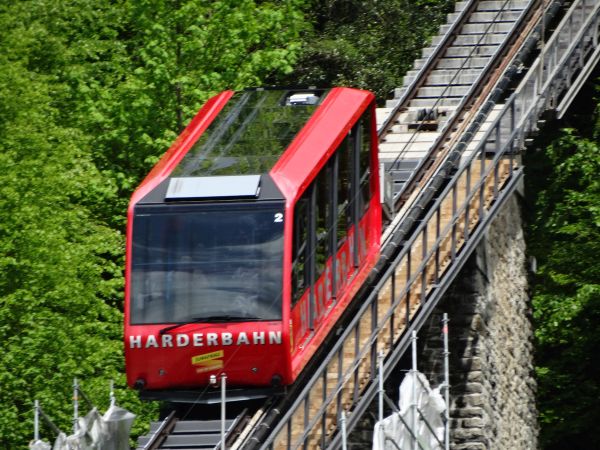
A closer look at the Harderbahn funicular wagon. Harderbahn was opened already in 1908 but these newest wagons are from 2008.
Picture from Interlaken Ost 13.5.2023 by Ilkka Siissalo.
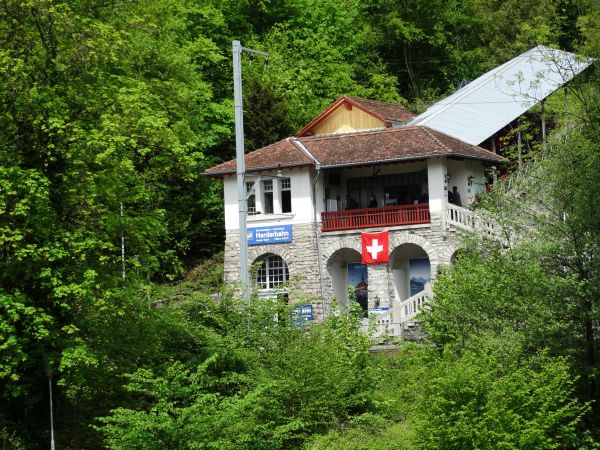
The lower end station of the Harderbahn.
Picture from Interlaken Ost 13.5.2023 by Ilkka Siissalo.
Polybahn
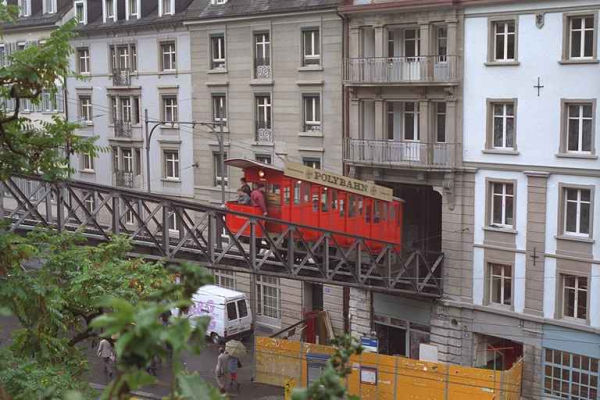
A funicular or Seilbahn is a usually very short stretch of railroad on a steep hillside where two identical coaches are tied at
opposite ends of a cable. Moving the cable moves both coaches simultaneously, one up and the other one down. This type of funiculars
are fairly common in all the Alpine countries.
This short funicular called "Polybahn" connects the famous technical university ETHZ, Eidgenössische Technische Hochschule
Zürich, to the square aptly named "Central" down by the Limmat river valley at the very heart of Zürich. The funicular was built
already in the 1800s, but has been recently thoroughly modernised.
Photo by Erik Hjelme 19 September 1995.
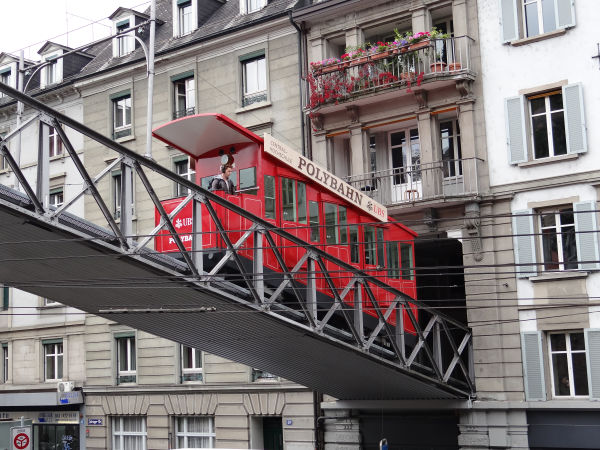
Polybahn is a very old funicular. The Zürichbergbahn company got a permission to build it in 1886 and the line opened in 1889. After heavy losses
it was threatened to be closed in the 1970s, but finally in 1972 a foundation was created to preserve the Polybahn. In 1976 the Union Bank of Switzerland
rescued Polybahn. It is now owned by the bank UBS, but operated by the city's traffic department Verkehrsbetriebe der Stadt Zürich.
Picture from the lower end station of Polybahn by the Centralplatz 1.10.2015 by Ilkka Siissalo.
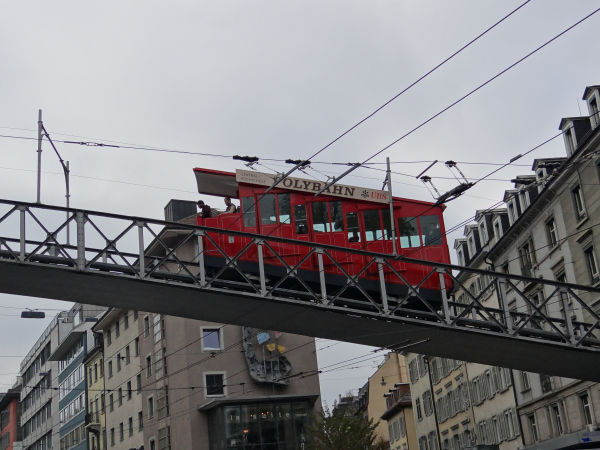
One of Polybahn's coaches crossing the street, just passing over trolleybus wires.
Picture from the lower end station of Polybahn by the Centralplatz 1.10.2015 by Ilkka Siissalo.
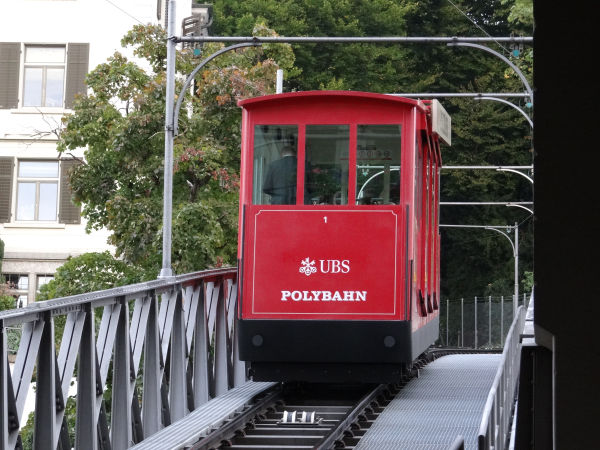
One of Polybahn's cabins, the no.1 rolling downhill towards Central and here just passing over the bridge that leads it over the street
Seilergraben.
Picture from the lower end station of Polybahn by the Centralplatz 2.10.2015 by Ilkka Siissalo.
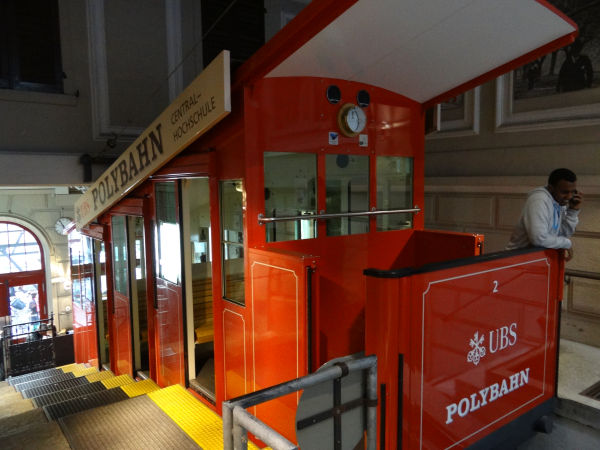
Polybahn's cabin no.2 at its lower end station inside a house by Central.
Picture from the lower end station of Polybahn by the Centralplatz 2.10.2015 by Ilkka Siissalo.
Funicolare Monte Brè
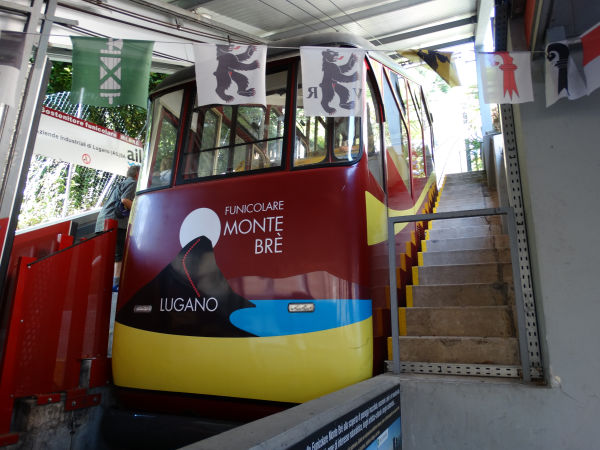
Funicolare Monte Brè is a small and old funicular which climbs from Cassarate by the city centre of Lugano up to Monte Brè. Actually the system
consists of two funiculars built one on top of the other so that passengers use the first funicular to climb from Cassarate in the city to
Suvigliana and then there is another funicular which takes them up to the hilltop at Monte Brè. This coach in the picture is one of the coaches
of the first, lower funicular.
Picture from Cassarate, Lugano 5.7.2019 by Ilkka Siissalo.
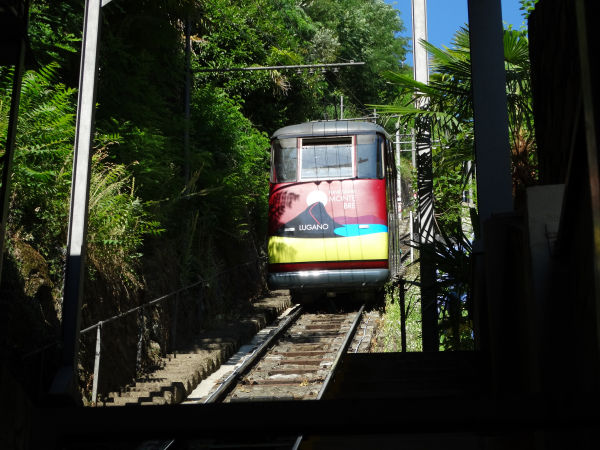
Here the lower funicular of Monte Brè is just leaving the end station of Cassarate.
Picture from Cassarate, Lugano 5.7.2019 by Ilkka Siissalo.
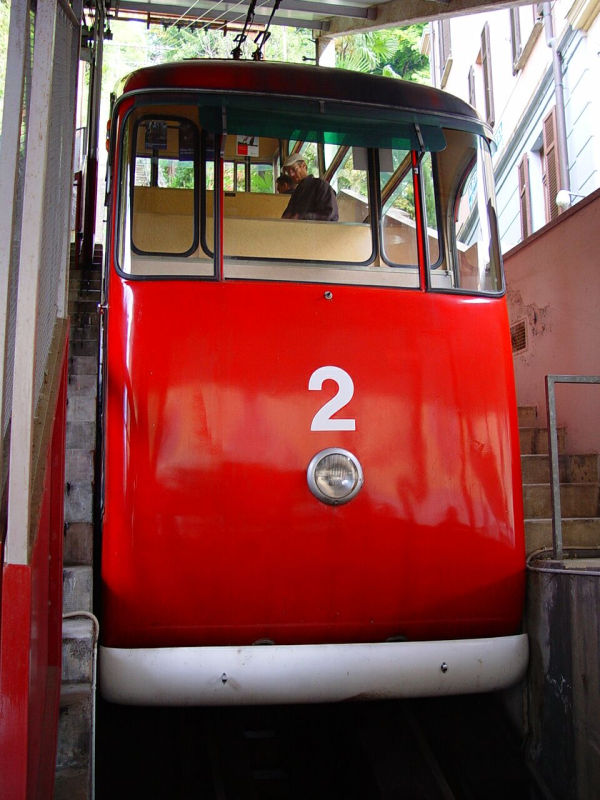
The same Cassarate to Monte Brè funicular as above, but shown before its latest modernisation and automation. The picture is from 2002.
Picture from Cassarate, Lugano 20.10.2002 by Ilkka Siissalo.
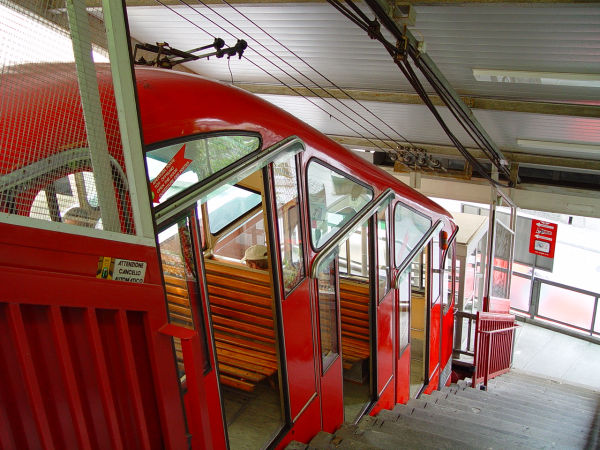
In 2002 there were no automatic glass doors or other automated security enhancements in place yet.
Picture from Cassarate, Lugano 20.10.2002 by Ilkka Siissalo.
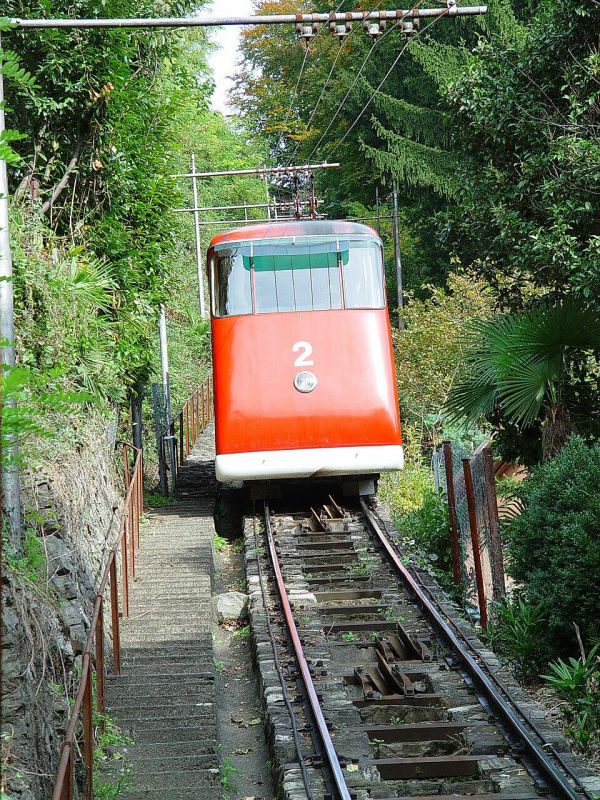
The Monte Brè funicular climbing up from Cassarate.
Picture from Cassarate, Lugano 20.10.2002 by Ilkka Siissalo.
Lugano Città–Stazione funicular, Sassellina
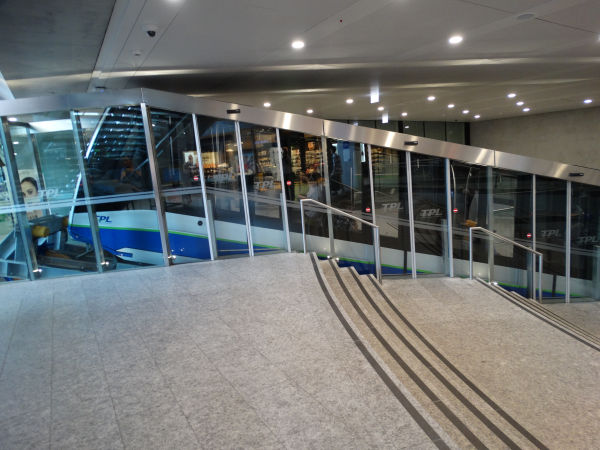
The city centre of Lugano is located by the lake, deep down at the bottom of a steep valley. The railway station of Lugano however is high up
on the mountainside, like on a shelf protruding from the mountain. A funicular has for tens of years been connectiong the city with its railway
station. It was just lately thoroughly modernised and is now totally automatic and protected by glass walls and automatic doors. The funicular
is known as the Lugano Città–Stazione funicular or also by the name Sassellina. The first funicular was opened here already at 1886 and at that time it was
water powered. Water from a mountain rapid was used to fill a wooden cask and the weight of the cask would push one of the wagons down the hill
while the other wagon would be pulled uphill. Then at the bottom of the hill the cask was emptied. The funicular was thoroughly renovated first in
1955 and again in 2016. The current modern wagons are from 2016.
Picture from Lugano railway station 5.7.2019 by Ilkka Siissalo.
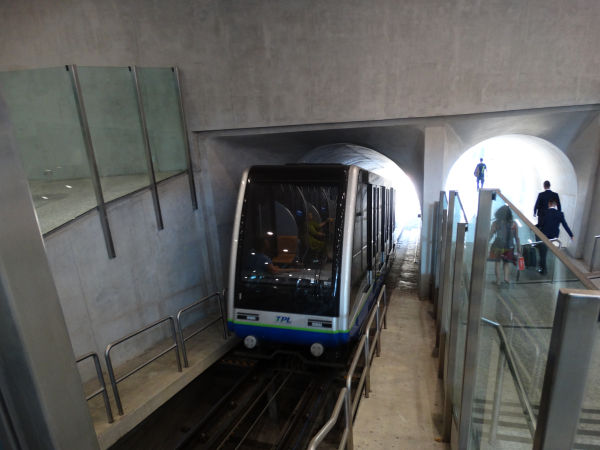
One of the funicular wagons has just left the Lugano railway station and has began its descent down towards the city centre.
Picture from Lugano railway station 5.7.2019 by Ilkka Siissalo.
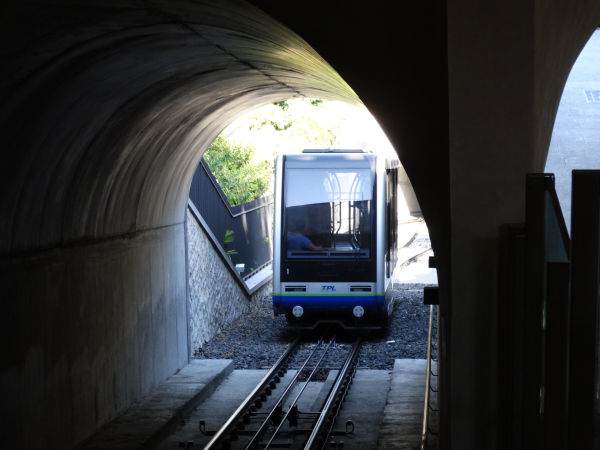
The descending funicular wagon has reached open space and will soon be meeting the other wagon which is coming uphill.
Picture from Lugano railway station 5.7.2019 by Ilkka Siissalo.

The same funicular before renovation. This picture is from 2002. No glass walls or automatic glass doors to be seen and the
coaches are still of the old type, built in the 1950s.
Picture from Lugano railway station 20.10.2002 by Ilkka Siissalo.
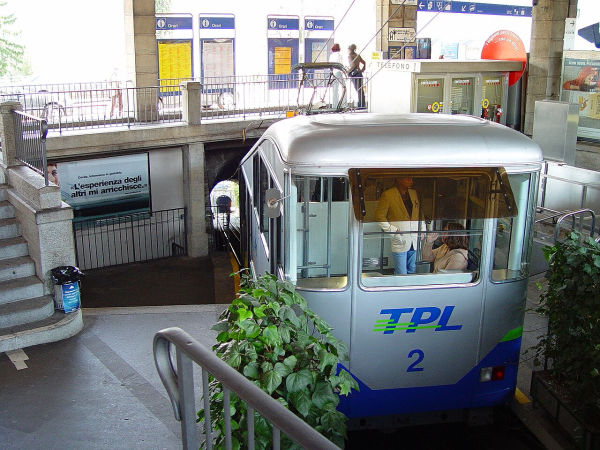
Lugano railway station down to city centre funicular in 2002.
Picture from Lugano railway station 20.10.2002 by Ilkka Siissalo.
Funicolare Lugano Paradiso - Monte San Salvatore
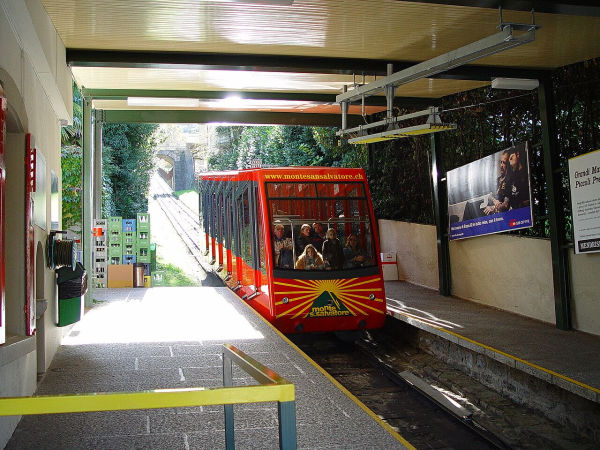
This funicular from Lugano Paradiso up to Monte San Salvatore is 1650 metres long and it is divided in two sections, so there
are actually two separate funiculars one after the other, just like there are at the Monte Brè side on the other side of the city of Lugano.
The system was thoroughly modernised last in 2001. This funicular is different from most other ones. Whereas in a common funicular system
two wagons are attached to opposite ends of the same wire and one is coming down as the other one is climbing up and the wagons meet in the
middle of the line, here, in this case, the line has been built in such a way that the two wagons never meet. One is climbing up to halfway
and then the passengers have to switch to the other wagon which will take them up the other half. So there is still just one wire, but the
two wagons are running on separate lines one after the other.
Picture from Lugano Paradiso 20.10.2002 by Ilkka Siissalo.
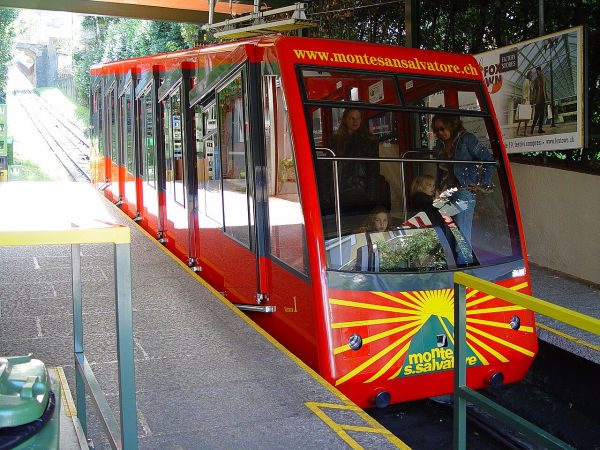
A closer look at the San Salvatore funicular wagon. The picture was taken in 2002 and the wagon is from 2001, so it was by then still brand new.
Picture from Lugano Paradiso 20.10.2002 by Ilkka Siissalo.
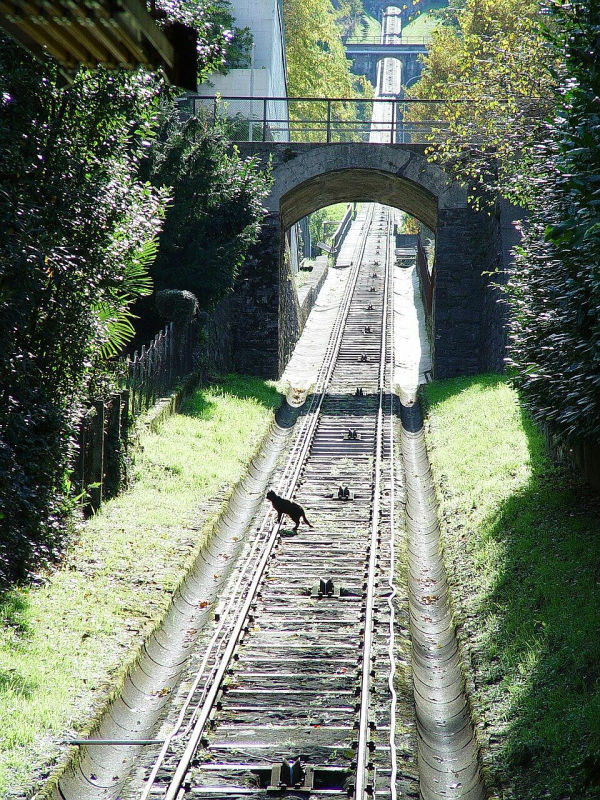
A cat is inspecting the funicular's very steeply uphill climbing track.
Picture from Lugano Paradiso 20.10.2002 by Ilkka Siissalo.
Funicolare Locarno - Madonna del Sasso
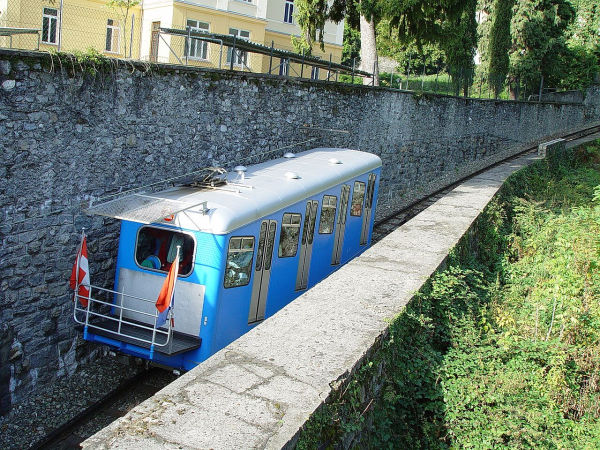
An old funicular is climbing from the city of Locarno uphill to Madonna del Sasso, which is a pilgrimage location high up on the hilltop. The funicular
was opened for traffic in 1906. The line is 811 metres long and there are four stops on the line.
Picture from Locarno 20.10.2002 by Ilkka Siissalo.

The lower end station of the funicular in Locarno.
Picture from Locarno 20.10.2002 by Ilkka Siissalo.
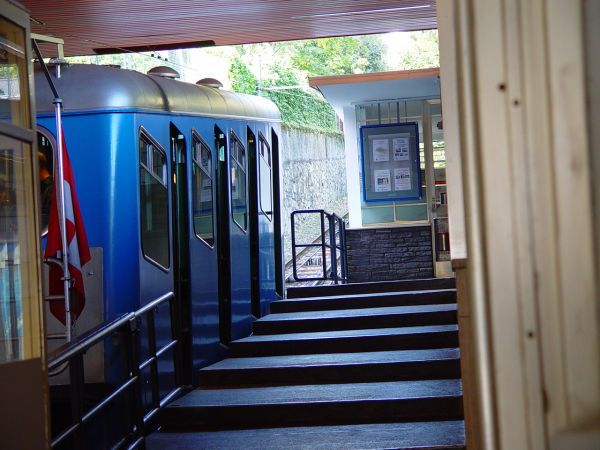
The funicular is ready to load passengers at the lower end station in Locarno.
Picture from Locarno 20.10.2002 by Ilkka Siissalo.
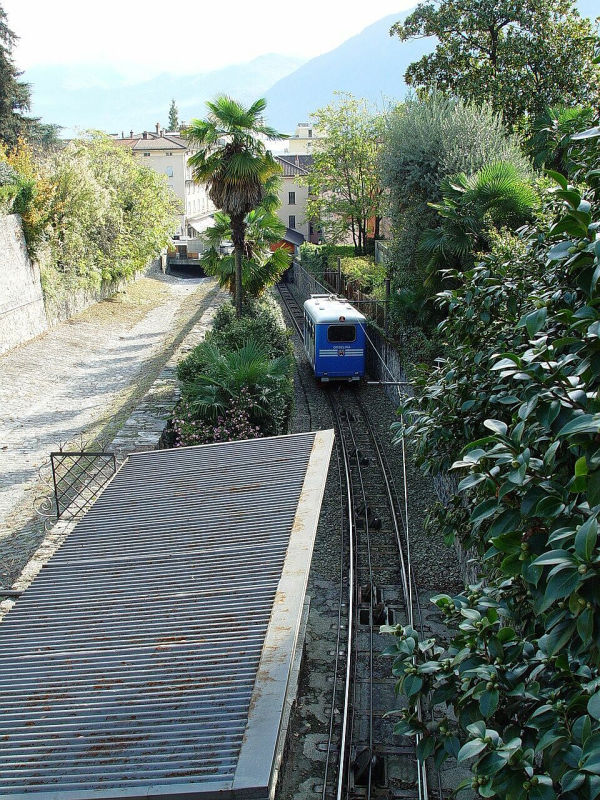
An ascending funicular wagon is soon going to reach the lower end station in Locarno.
Picture from Locarno 20.10.2002 by Ilkka Siissalo.
Niesenbahn
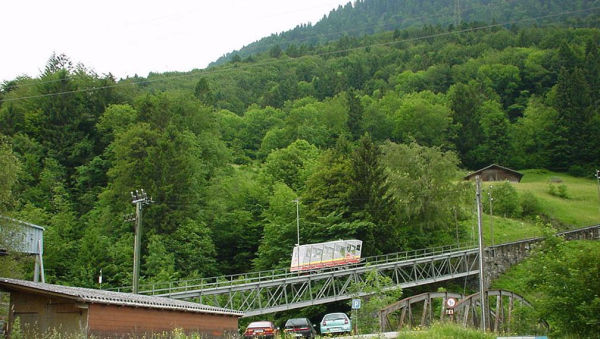
Niesenbahn is a small mountain train. It is not actually a funicular but it works using cog wheel technology, with independent coaches.
Niesenbahn is located in the mountain valley which leads from Thun and Interlaken south towards Lötschberg and Kandersteg, the
Engstligental. It rises from Mülenen, a small village and station in the valley by the BLS Lötschberg line, to the peak of Niessen,
2362 metres high.
Photo from Mülenen in June 1999 by Ilkka Siissalo.
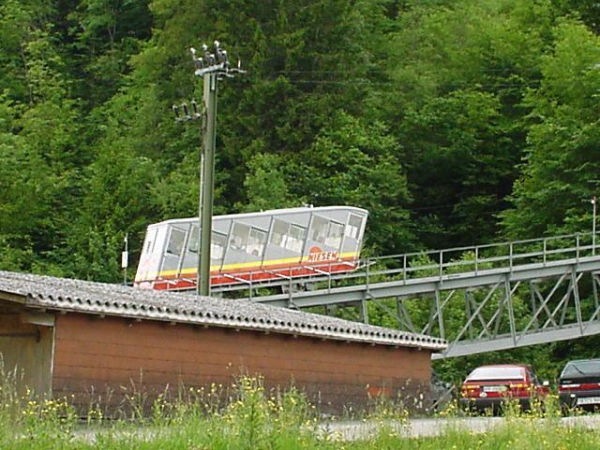
Another view of the Niesenbahn mountain train, very similar with the famous Pilatusbahn close to Luzern. The track starts from
Mülenen by crossing a bridge over the river Engstlige; even there the track is climbing pretty steeply up.
Photo from Mülenen in June 1999 by Ilkka Siissalo.
Reichenbachfall
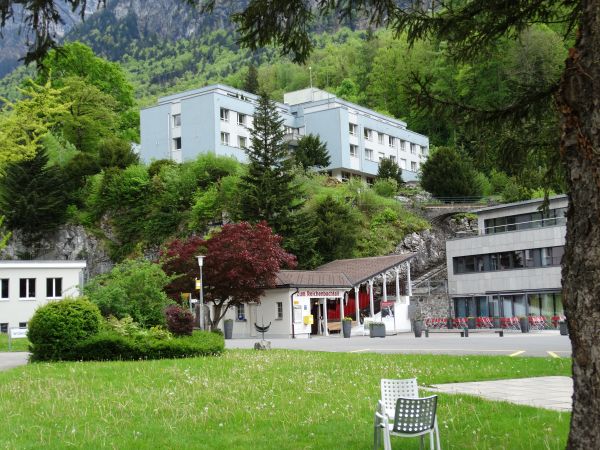
The Reichenbachfall (Rychenbach in the local dialect; Rych or Rauch in real German means smoke or also water aerosol fumes, Bach means a small river
and Reichen refers to very rich people.) is a very famous and very tall waterfall above the village of Meiringen in central Switzerland.
It's actually not just one waterfall, but a cascade of seven waterfalls which drop down some 250 meters and the small river of Reichenbach thereby
loses some 290 metres in height along these falls. The largest one of these waterfalls, the Grosser Reichenbachfall (Grand Reichenbach Fall) was
made famous by the author Sir Arthur Conan Doyle who wrote that his immensely famous figure Sherlock Holmes died here while chasing his ultimate
foe professor Monarty.
This old funicular, Reichenbachfallbahn was taken in use 1899 and it has last had a major renovation in 1999. It climbs up 714 metres to the largest
of the waterfalls, the Grosser Reichenbachfall.
Picture from Meiringen 13.5.2023 by Ilkka Siissalo.

Wagon no.2 of the Reichenbachfallbahn. It looks like new although it is from 1899 !
Picture from Meiringen 13.5.2023 by Ilkka Siissalo.
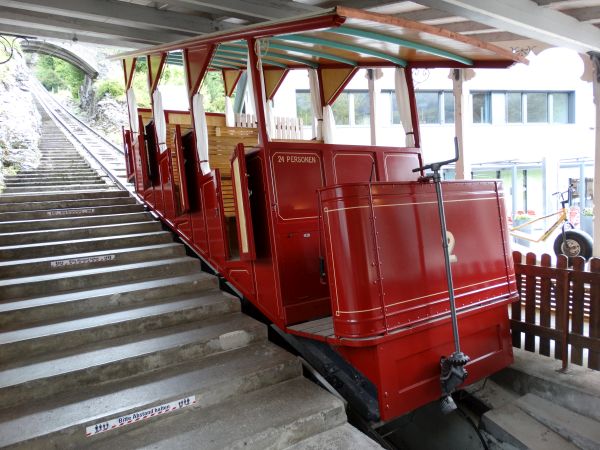
Another view of the wagon no.2 of the Reichenbachfallbahn. Perfect condition !
Picture from Meiringen 13.5.2023 by Ilkka Siissalo.
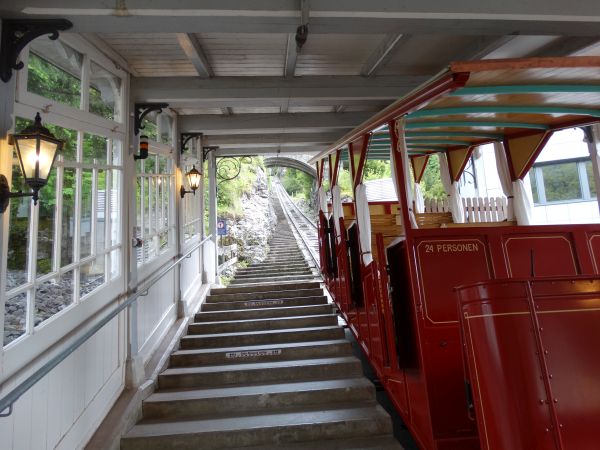
A view uphills from the lower end station of the Reichenbachfallbahn.
Picture from Meiringen 13.5.2023 by Ilkka Siissalo.
Funicular Rigiblick, Zürich
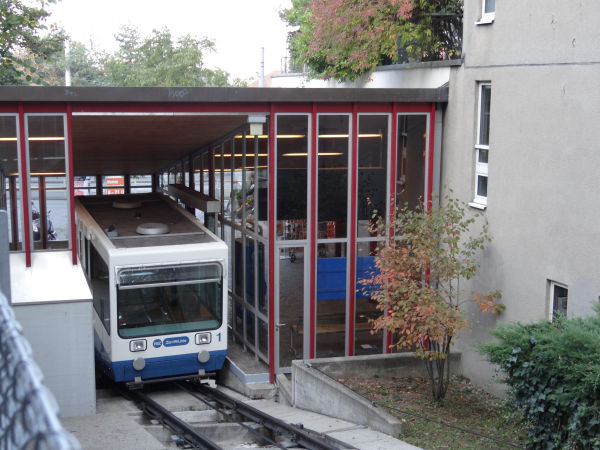
The funicular Rigiblick is a modern, fully automated funicular in the city of Zürich, climbing from the tramstops of tramlines 9 and 10
to the hilltop of Zürichberg. The current modern coaches are from the 1970s. The line is operated by VBZ, Verkehrsbetriebe der Stadt Zürich, which is
the municipal tram and bus operator.
Picture from the tramstop Seilbahn Rigiblick, the lower end station of the funicular, 3.10.2015 by Ilkka Siissalo.
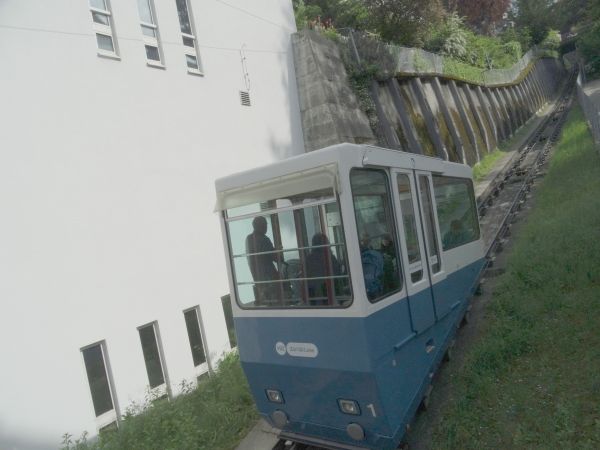
Here one wagon of the funicular Rigiblickbahn has just left the lower end station next to the tramstop Seilbahn Rigiblick and has started its ascent
towards the high hills of the Zürichberg. This may have been one of the last opportunities to still photograph this old funicular, as the
Verkehrsverbund Zürich ZVB has already ordered new funicular wagons to replace these ones and they are expected to arrive very soon.
Picture from the tramstop Seilbahn Rigiblick, the lower end station of the funicular, 9.5.2023 by Ilkka Siissalo.

A second view of the old Rigiblickbahn as it has started its climb up.
Picture from the tramstop Seilbahn Rigiblick, the lower end station of the funicular, 9.5.2023 by Ilkka Siissalo.

A moment later the second wagon descends to reach the lower end station. This funicular is totally automated. It runs according to a timetable,
but does not start unless at least one passenger is detected onboard either one of the wagons.
Picture from the tramstop Seilbahn Rigiblick, the lower end station of the funicular, 9.5.2023 by Ilkka Siissalo.
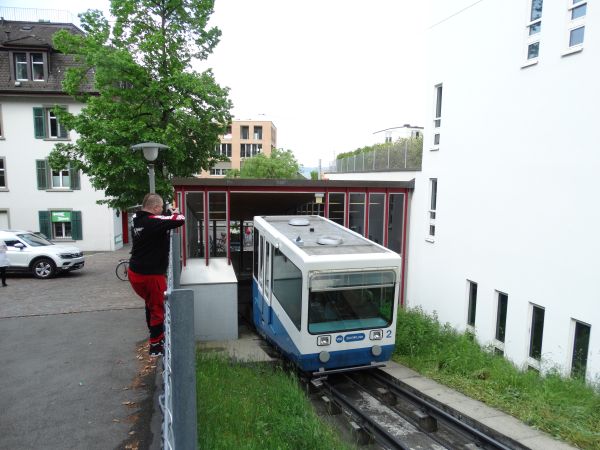
Transpotter Matti Heino records a video as the wagon no.2 slowly comes to a halt at the lower end station.
Picture from the tramstop Seilbahn Rigiblick, the lower end station of the funicular, 9.5.2023 by Ilkka Siissalo.
Unterwasser - Iltiosbahn
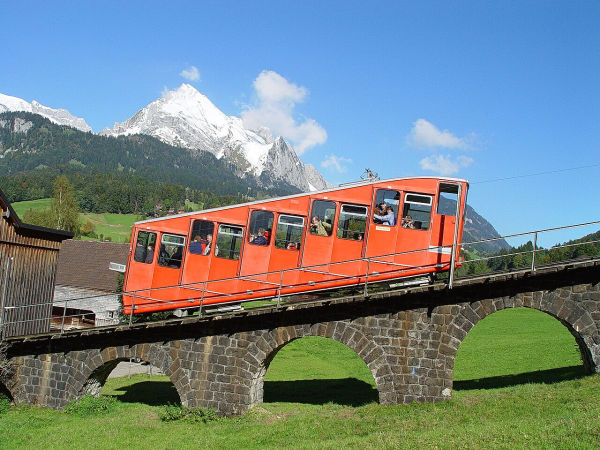
The Unterwasser - Iltiosbahn funicular is located in Kanton St. Gallen and it runs from Unterwasser down by the
valley up to Iltios in Obertoggenburg and is part of the company Toggenburg Bergbahnen AG. Unterwasser at the
lower end is at 911 metres above sea level and Iltios is 1339 metres above sea level. From the upper end station
Iltios continues a cable car Iltios to Chäserrugg on top of the 2262 metres high Chäserrugg (cheesemaker's back).
This funicular was opened in 1934 and thoroughly modernised in 2005, so these pictures have been taken before its
modernisation. In the modernisation the track gauge was changed from 80 cm like in these pictures to metre gauge
and new wagons were ordered, which at least were intended to be received by 2012. The editors of this site have
no data if ths really took place or not. These are pictures of the old Unterwasser to Iltios railway.
Here one of the two Unterwasser to Iltios funicular wagons is just leaving the lower station of Unterwasser.
Picture 29.9.2002 by Ilkka Siissalo.
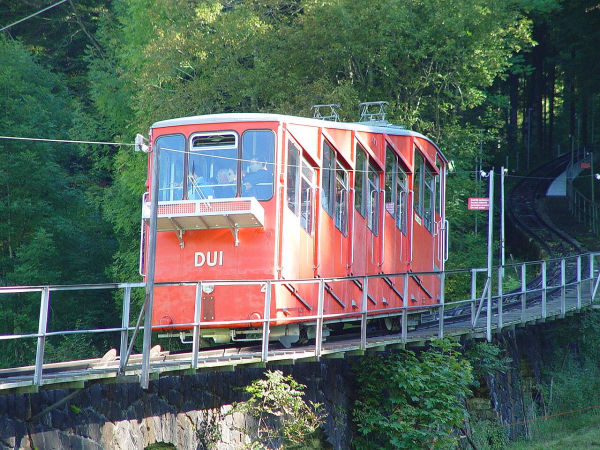
As the wagon no.1 was ascending, the wagon no.2 was descending towards Unterwasser, here already close to the lower station.
Note the two small pantographs on the roof of the wagon. There are no catenary wires, so these two pantographs can only feed
electricity to the wagon during stops at either the lower or upper terminus. Two pantos indicate they are feeding three
phase AC current, probably for heating the wagon.
Picture of wagon no.2 coming down to Unterwasser 29.9.2002 by Ilkka Siissalo.

